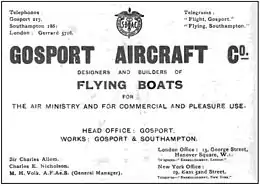Gosport Aircraft Company
The Gosport Aircraft Company was a short-lived British aircraft manufacturer based at Gosport, Hampshire formed at the start of the First World War by Sir Charles Allom of White, Allom & Company and Charles Ernest Nicholson of Camper and Nicholsons boat-builders. The company built a number of flying-boats for the British government including the hull for the Fairey Atalanta which at the time was the largest flying-boat hull built in the world.[4]
| Type | Privately held company |
|---|---|
| Industry | Aerospace |
| Fate | Out of business c. 1919 |
| Founded | c.1914 |
| Defunct | 1920 |
| Headquarters | , |
Number of locations | 3 |
Key people | Sir Charles Allom Charles Ernest Nicholson Magnus Herman Volk AFRAeS John Cyril Porte Lt.-Col. Ralph Hope-Vere. AFC[1][2] Francis Percy Beadle[3] |
| Products | Flying boats |
Aircraft
- FBA Type B pusher biplane patrol flying boat, flying surfaces for sixty built for the RNAS.
- Felixstowe F.5 tractor biplane patrol flying boat, cancelled by the RAF in January 1919 after ten from an order of fifty delivered.
Projects

Following the end of the First World War, the company proposed a number of designs published 31 July 1919 in Flight magazine:[5]
- Gosport Fire Fighter - a 10-seater flying boat designed to carry men and material to the scene of a forest fire or emergency based on the Felixstowe F.5.
- Gosport Mail - a six passenger luxury flying boat for long distance passenger, mail and goods-carrying based on the Norman Thompson N.T.4A.
- Gosport Patrol Boat - a two-seater flying boat for use as a fast patrol or police boat.
- Gosport Two-seater Touring Boat - a flying boat with a tail boom for the American market.
- Gosport Popular - a touring flying boat.
- Gosport Shrimp - a single-seat flying boat.
In December 1919 a number of larger flying-boats were proposed, designed by John Porte who joined the company in August 1919:[6]
- Gosport G5 - a twin-engined biplane flying boat with a 103 ft span and a length of 49 ft 3in, for two crew and six passengers or cargo based on the Felixstowe F.5.
- Gosport G5a - a smaller variant of the G5 with a 97 ft 6in span and only 46 ft in length.
- Gosport G8 - a biplane flying boat for one pilot and three-passengers.
- Gosport G8a - a biplane flying boat similar to the G8.
- Gosport G9 - a triplane three-engined flying boat for long distance cargo work or ten passengers with three crew, which would have had a 113 foot wingspan. A commercial version of Porte's Felixstowe Fury[7]
With the death of Porte in October 1919 none of the flying boats proposed were built, and by the middle of 1920 the company had closed.
References
- Gosport Aircraft and Engineering Company (7 July 1920). "1920: Gosport Aircraft Co". Aviation Ancestry. The Aeroplane. Retrieved 10 February 2017.
- "Awarded the Air Force Cross". Supplement to the London Gazette: 97. 1 January 1919. Retrieved 10 February 2017.
- Moss, Roger. "Francis Percy Hyde Beadle". British Aviation - Projects to Production. Retrieved 10 February 2017.
- "The Largest Flying-Boat Hull in the World". Flight. 10 April 1919. p. 481.
- "The Gosport Flying-Boats". Flight. 31 July 1919. p. 1006.
- "Some Gosport Flying Boats for 1920". Flight. 25 December 1919. pp. 1657–1658.
- Flight "Felixstowe Flying Boats" p.931 23 December 1955